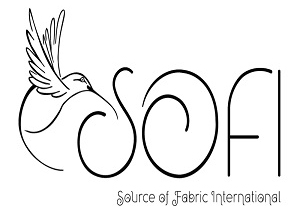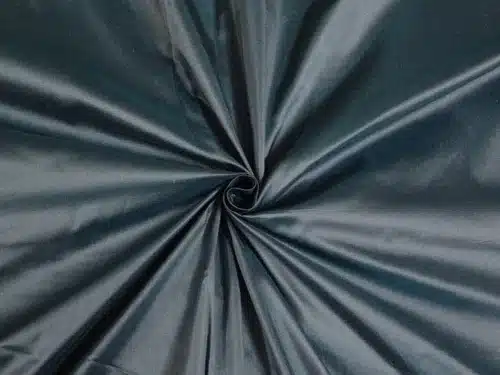Because of its distinctive texture, opulent feel, and numerous applications, taffeta fabric has long been a favorite in the fashion and textile industries. Taffeta’s brilliant sheen and crisp, smooth finish make it a unique fabric for anybody wishing to add elegance to their works, whether they be evening gowns or home décor. Continue reading to learn more about taffeta and the reasons it remains a mainstay in interior design and fashion. This tutorial will cover the main characteristics, varieties, and applications of taffeta fabric, along with some maintenance advice.
Taffeta fabric: what is it?
Made from silk or synthetic fibers like polyester or nylon, taffeta is a smooth, crisp fabric. In the past, silk was used to make taffeta, which was valued for its opulent and glossy look. Taffeta is now more widely accessible and reasonably priced because of its availability in a range of synthetic fibers. This fabric is perfect for structured designs like ball gowns, bridal dresses, and intricate drapes because of its smooth surface, slight rustling sound when moved, and ability to keep shape.
The way the threads are weaved gives taffeta its shine, giving it a glossy, smooth surface. The fabric is a favorite for formal wear and special occasions because of its slightly stiff texture, which helps it maintain its shape and produce voluminous silhouettes.
Taffeta fabric types
Taffeta fabric comes in a variety of forms, each with special qualities. The primary kinds are as follows:
1. Silk Taffeta
Known for its exquisite sheen, silky smoothness, and gentle drape, silk taffeta is the most opulent and original type of taffeta. Its opulent texture and visual attractiveness make it a popular choice for bridal gowns and expensive evening clothing.
2. Polyester Taffeta
This less expensive substitute for silk taffeta has a similar appearance and texture. It is frequently utilized in party dresses, home décor, and ready-to-wear fashion. Compared to silk, it is easier to maintain, more resilient to wrinkling, and more durable.
3. Nylon Taffeta
Lightweight, strong, and slightly shiny, nylon taffeta is comparable to polyester taffeta. It is frequently used for inlining skirts and dresses as well as outerwear like jackets.
4. Duchess Taffeta
A thicker, more sumptuous type of taffeta that designers frequently use in lavish and regal fashion designs. It creates dramatic volumes and intricate designs, making it ideal for structured dresses and gowns.
Qualities of Fabric Taffeta
Taffeta is an exceptional fabric for a wide range of applications due to its unique properties. Among its most noteworthy attributes are:
Shiny and Lustrous Finish: The bright sheen of taffeta fabric is frequently connected to opulence. It is ideal for nighttime wear, weddings, and other special occasions because of the glamorous touch this shimmering finish offers.
Stiff and Crisp Texture: Taffeta frequently works well for clothing and accessories that need volume, such as long skirts or puffed sleeves, because it maintains its shape nicely. Another reason the cloth is popular for sophisticated draperies is its sharpness.
Rustling Sound: Taffeta’s faint rustling sound when moved is one of its distinctive qualities. This sound enhances its opulent appeal, lending sophistication and elegance to any setting in which it is used.
Durability: In general, taffeta is resilient, particularly when composed of synthetic materials. Because of their exceptional resistance to deterioration, polyester, and nylon taffeta are appropriate for a wide range of uses, including household textiles and clothing.
Uses for Taffeta Fabric
Both the fashion and interior design sectors make extensive use of taffeta. Among its most popular uses are:
Bridal & Evening Wear: Because it retains structure and produces a dramatic, voluminous silhouette, taffeta is frequently the fabric of choice for wedding dresses, prom gowns, and cocktail dresses. The fabric is a favorite in high-end fashion because of its silky finish and opulent appearance.
Formal Dresses: Taffeta is a popular material for formal dresses, including ball gowns, mother-of-the-bride dresses, and bridesmaid gowns, due to its beautiful sheen and crisp texture. The secret to producing intricate, beautiful designs is its capacity to maintain its shape.
Home décor: Taffeta is used in drapes, curtains, and upholstery, among other textiles. It’s perfect for producing a high-end look in dining rooms or living rooms because of its smooth surface and capacity to create an opulent environment.
Accessories: Handbags, ribbons, and scarves are among the items made from taffeta. The gloss and texture of the fabric give each accessory a unique touch that makes it stand out.
How Taffeta Fabric Should Be Maintained
Although taffeta is beautiful, it can be delicate, especially when made from silk. The following advice may help you take good care of your taffeta clothing or home accents:
Dry Clean Only: To maintain its gloss and texture, always dry clean silk taffeta. You can often machine wash taffeta made of polyester or nylon, but make sure to follow the care instructions to avoid damaging the fabric.
Avoid Ironing on High Heat: High heat might damage taffeta. If ironing is required, use a low-temperature setting and place a cloth between the iron and the fabric to prevent burning or damaging the fibers.
Store Carefully: Keep taffeta clothing out of direct sunlight and store it in a cool, dry location to avoid fading. Use padded hangers or garment bags to preserve the shape of the fabric while storing a formal dress or piece of home décor.
In conclusion
Taffeta’s opulent texture, sheen, and adaptability make it a classic fabric that has endured. Taffeta lends a sense of sophistication and elegance to every endeavor, whether you’re making a gorgeous evening dress, furnishing your house, or searching for the ideal accessory. You can get the most out of this adaptable cloth and appreciate its beauty for many years to come if you know its various sorts and traits.
Make sure to get the right kind of taffeta and take the necessary precautions to maintain its best appearance if you’re thinking of utilizing it for your next design or home décor project. Taffeta is still one of the most classic and refined fabric options, which makes it essential in the fashion and design industries. For those working with taffeta or other fabrics, Dyeing Services can help enhance the fabric’s color and ensure it looks its best throughout its use.


